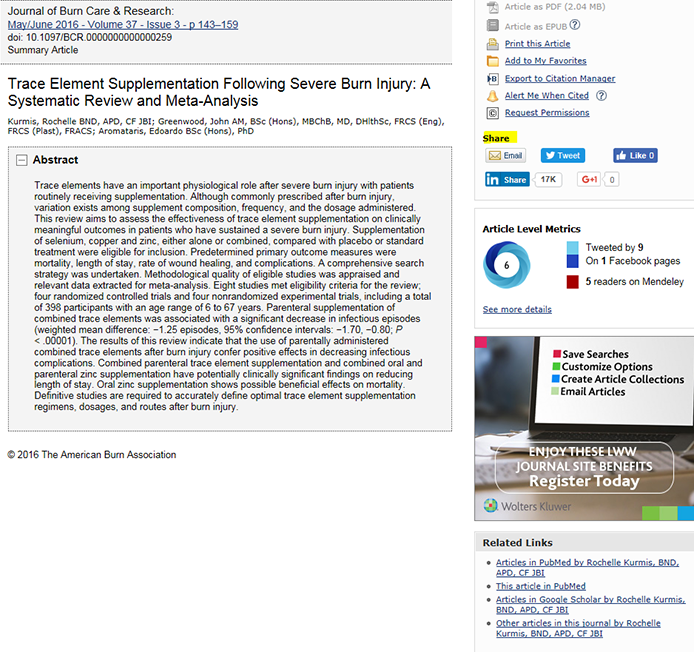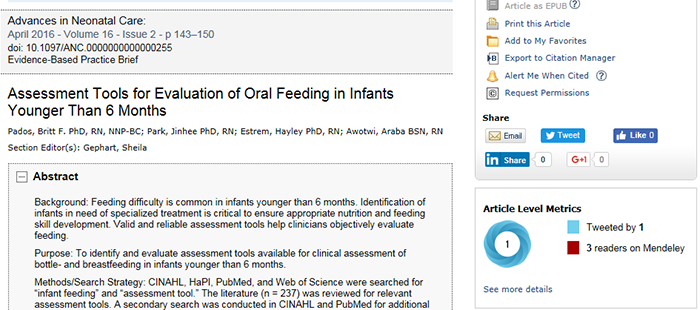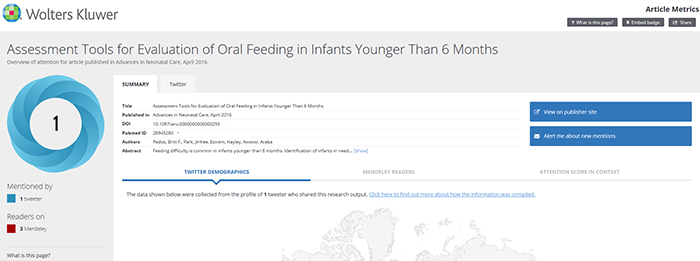Increasing the Visibility of Your Work with Social Media
SEP 2016Publishing your research in scholarly journals is important, but what may be even more important is getting the scientific information into everyday communication streams. Today that is social media. This editorial outlines how best to move your scholarly work into social media outlets and how to track your success in a social media world.
Increasing the visibility of your work with social media. First, you will need an account in a social media network. If you are going to use the account for both professional and personal postings, be sure to ponder your audience. You might want to consider having 2 separate accounts, one for your personal use and one for your professional use. You might also want to consider how you will title your account and whom you will invite to be your friends (whom you are connected to) within each account. Each account might have different followers, and possibly the followers could be overlapping depending on the types of contact you have with them. Once you have an account, you can begin by making thoughtful posts 2 to 3 times each week. (See Figure 1 for some social media definitions and tips for using social media.) For example, if your research or clinical expertise is related to family-centered care, you can post breaking findings around the topic as they occur. Of your 3 weekly posts, one should be related to your own work and the other 2 should bring in the latest research or clinical practices from other teams. In this way, you can begin a conversation around your topic. Additions from other teams can be found by checking Google Alerts or the table of contents of your favorite journals. If you use the journal Web site, the site often has a sharing link with each article that connects to social media sites so that you can easily post the information. (see picture below)

Sharing your published article can now easily be done right from your article page; on the right side of the page is a share section where if you are logged into Facebook (for example), you can choose to “like” the article and it will be shared on your own Facebook page.
If you use this means for posting, be sure to link the post to your Web page. Once you decide what information you want to post, be sure to add a sentence or two that tells readers why they would want to look into getting more information about this topic. You will want to be intentional about your posting, so take the time to reflect about the story you are trying to tell or the message you want readers to get from checking out your page.
Tracking the success of your scholarly work in social media. Tracking the uptake of your work is not just about checking your social media site to see how many “likes” and comments you have received about your post. Tracking is also about how your post is shared, and hopefully shared again, and again. Wolters Kluwer, the publisher for ANC and many other scholarly journals, has adapted Altmetrics as a social network tracking strategy for following how individual articles published in its journals are being viewed on social networking sites. See below for where to find the Altmetrics widget on your published article page on the ANC Web site (http://journals.lww.com/advancesinneonatalcare/pages/default.aspx).

Click on the altmetrics circle and you get this screen:

The Altmetrics widget shows you how your work is being shared on different social networks. You will be able to see a summary of the impact of your work in a social media world, with a list of where it has been shared and how many times it has been shared or commented on by others. You can even click on the widget to get more details about exactly where and by whom your article has been shared and whether there are comments about your work. We encourage you to post your own work and get comments to increase the visibility and impact of your work in a social media world.
This is an excerpt from a journal article, with images added. McGrath, Jacqueline M. PhD, RN, FNAP, FAAN; Brandon, Debra PhD, RN, CCNS, FAAN. “Scholarly Publication and Social Media: Do They Have Something in Common?” Advances in Neonatal Care. August 2016 - Volume 16 - Issue 4 - p 245–248. doi: 10.1097/ANC.0000000000000319
 Back to Author Resource Review
Back to Author Resource Review